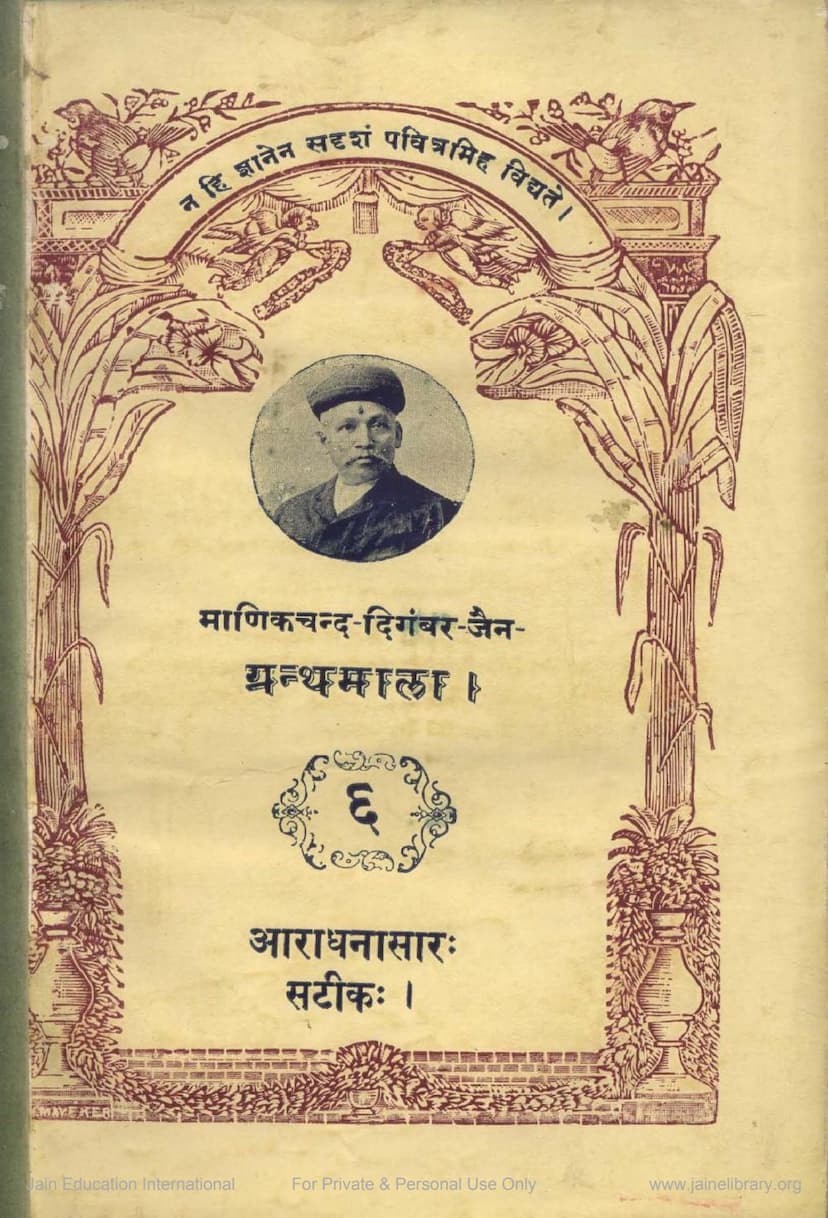AradhanasaraSatika
Added to library: September 1, 2025

Summary
This document is a scanned copy of the Jain text "Ārādhanāsāra" (आराधनासारः) by Acharya Devsena, with a commentary (Ṭīkā) by Acharya Ratnakīrti. It was published by the Manikchand Digambar Jain Granthamala Samiti.
Here's a comprehensive summary of the content based on the provided pages:
Overall Purpose and Content:
The book is a detailed exposition on the path of spiritual practice and liberation according to the Digambara Jain tradition. It primarily focuses on the "essence of worship" (Ārādhanāsāra), which is understood as the practice of virtues and the pursuit of the true self, leading to liberation.
Key Themes and Structure:
The text, as indicated by the initial pages and the commentary, is structured around explaining and elaborating on the path to liberation. It begins with traditional invocations and a statement of purpose. The core of the text is the explanation of the "Ārādhanāsāra," which is divided into two main aspects:
-
Vyavahāra Ārādhanā (व्यवहार आराधना - Practical/Conventional Worship): This refers to the external practices and observances that lead the soul towards spiritual progress. It encompasses:
- Darśana Ārādhanā (दर्शन आराधना - Right Faith/Perception): Understanding and believing in the true nature of reality, the soul, and other substances as taught by the Jinas. This involves adherence to principles derived from scriptures and logic.
- Jñāna Ārādhanā (ज्ञान आराधना - Right Knowledge): The process of acquiring and understanding the true meaning of scriptures and the nature of reality. This involves study, contemplation, and gaining correct knowledge.
- Cāritra Ārādhanā (चारित्र आराधना - Right Conduct): The practical adherence to vows and ethical principles, including the thirteen categories of conduct (five great vows, five restraints, three controls). It also emphasizes the importance of internal purity (bhāva śuddhi).
- Tapas Ārādhanā (तप आराधना - Austerity/Penance): The practice of austerities, both external (like fasting) and internal (like penance, humility, study, meditation), which helps in shedding karma.
-
Niścaya Ārādhanā (निश्चय आराधना - Essential/Ultimate Worship): This refers to the internal, direct realization and experience of the pure, liberated self. It is described as:
- Oneness with the Self: Recognizing the soul as distinct from all external substances and bodily attachments.
- Absence of Mental Projections: Attaining a state where the mind is free from all dualistic thoughts, desires, and attachments.
- Pure Consciousness: Experiencing the self as pure consciousness, knowledge, and bliss, unadulterated by karma or external influences.
- Liberation: The ultimate goal, where the soul is freed from the cycle of birth and death (samsara) and attains eternal happiness and omniscience.
Commentary (Ṭīkā) by Ratnakīrti:
Acharya Ratnakīrti's commentary is extensive and aims to clarify the profound meanings within Devsena's original text. The commentary delves into various interpretations of terms, explains philosophical concepts, and provides elaborations on the practices described. The detailed explanations for each verse suggest a deep dive into the nuances of Jain philosophy and practice.
Specific Points Highlighted (from the initial verses and commentary):
- Invocation: The text begins with salutations to the Jinas, Saraswati (goddess of knowledge), and gurus, seeking their blessings for the removal of obstacles.
- Author's Intent: Acharya Devsena states his intention to expound the "Ārādhanāsāra" after paying homage to the Siddhas and Mahavira, the ultimate liberated beings.
- Nature of Ārādhanāsāra: It is described as the essence of worship, a combination of austerity, right faith, right knowledge, and right conduct.
- Two Divisions: The Ārādhanāsāra is explicitly divided into "Vyavahāra" (conventional) and "Paramārtha" (ultimate/essential).
- Explanation of Vyavahāra: This section details the four components (Darśana, Jñāna, Cāritra, Tapas) as understood in the conventional sense, as taught by the Jinas.
- Explanation of Darśana Ārādhanā: This involves faith in the soul and other substances based on scriptural reasoning. It discusses the different types of right faith (aupaśamika, kṣāyopaśamika, kṣāyika) and their causes.
- Explanation of Jñāna Ārādhanā: This involves understanding the meaning of scriptures and reality, achieved through various means like study and contemplation.
- Explanation of Cāritra Ārādhanā: This involves practicing the thirteen-fold conduct, emphasizing internal purity and detachment from the two types of non-restraint (indriya-asaṃyama and prāṇa-asaṃyama).
- Explanation of Tapas Ārādhanā: This involves practicing the twelve types of austerities, both external and internal, to shed karma.
- Transition to Niścaya Ārādhanā: The text then moves to explain the ultimate path, where the soul realizes its pure, self-reliant nature, free from all dualities and attachments.
- The Pure Self: The pure soul is described as being without any external support or attachments, free from all mental modifications.
- Attaining the Self: The path involves realizing the true nature of the self, abandoning attachments to sensory objects, and purifying oneself from inner impurities like attachment and aversion.
- The Role of Detachment: Complete detachment from worldly pleasures and even the body is crucial for realizing the true self.
- The Path of the Virtuous: The text describes the characteristics of an "Ārādhaka" (one who worships or practices) as someone who has conquered passions, attained right knowledge and faith, and is detached from possessions.
- Overcoming Obstacles: It emphasizes the importance of enduring hardships (parīṣaha) and suppressing mental distractions (manas) to achieve the ultimate goal.
- Karma Destruction: The ultimate aim is the destruction of all karma, which leads to liberation and the experience of eternal bliss.
- The Final Goal: The liberated soul (Siddha) is described as being eternally blissful, omniscient, and dwelling in the highest abode, free from all worldly limitations.
Publisher and Editorial Information:
The book was printed by Chintaman Sakharam Deole at the Bombay Vaibhav Press and published by Nathuram Premi, Honorary Secretary of the Manikchand Digambar Jain Granthmala Samiti. The document also acknowledges the help of Shri Shitalprasadji Brahmachariji in obtaining a copy of the manuscript.
In essence, "Ārādhanāsāra" is a profound spiritual guide that systematically explains the Jain path to liberation, beginning with preparatory practices and culminating in the ultimate realization of the pure, blissful soul.